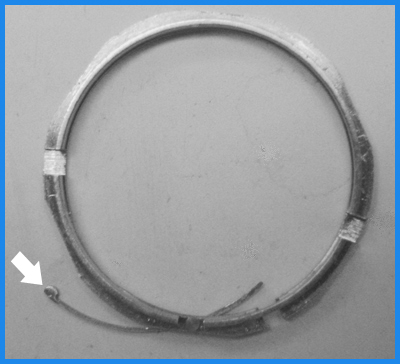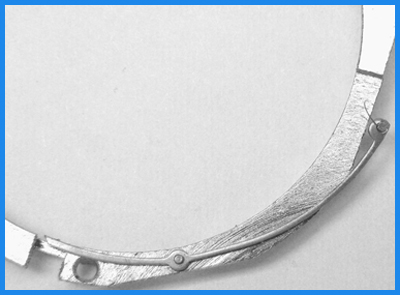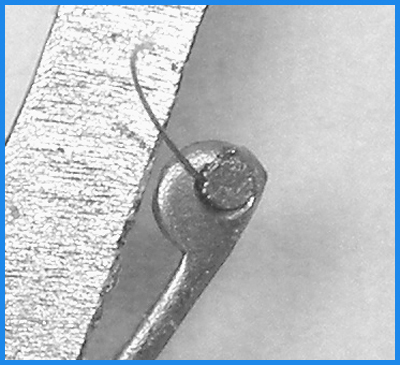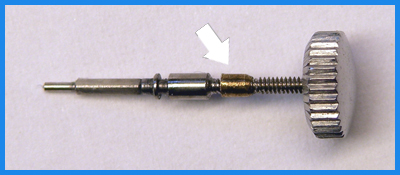

Vintage & Antique
Watch Repair
Servicing the Glycine Airman Hack Device
Servicing Glycine Airman watches is a relatively straight forward process. The basic movement is the same as other Swiss auto-winding movements of the period. The difference lies in the repairer's knowledge of how to properly handle the hack mechanism so as not to damage the wire, which serves to stop the second hand at the zero point on the dial. This page details the differences in the Glycine Airman watch compared to other watches of the period.
The tiny steel hack wire, which comes up through the dial when the stem is pulled into the setting position can easily be damaged or broken if the repairer does not use the proper procedure when removing the movement from the case, and also when removing the movement ring from the movement. It is the movement ring to which the lever holding the wire is attached.
The hack wire measures six hundredths of a millimeter (.06 mm) in diameter. This is about the same diameter as an average human hair. In inches it is equal to 0.0024". The wire is hardened sufficiently so as to be elastic. Elastic in this case means the wire will bend, but then spring back to its original shape. This elastic property assumes the wire is not stressed beyond its elastic limit by mishandling.
The elasticity is important because in order for the wire to move up and down through the opening in the Airman dial, it must be capable of slightly bending without permanently deforming.
This image(below) is a Glycine Airman movement ring with the attached hack lever.
 The white arrow points to the end of the lever, which
holds the
hack wire. At the bottom of the image, just to the left of center is
the pivot pin for the lever. This pin is a press fit into the movement
ring. The two notches at 9:30 and 3:30 are for the case
clamps. The case clamps, flat metal pieces that are screwed to the
movement, serve to hold the
movement securely in the case. The opening in the ring near the right
end of the lever is to allow the stem to pass from the case into the
movement.
The white arrow points to the end of the lever, which
holds the
hack wire. At the bottom of the image, just to the left of center is
the pivot pin for the lever. This pin is a press fit into the movement
ring. The two notches at 9:30 and 3:30 are for the case
clamps. The case clamps, flat metal pieces that are screwed to the
movement, serve to hold the
movement securely in the case. The opening in the ring near the right
end of the lever is to allow the stem to pass from the case into the
movement.
This image (below) is of the Glycine Airman hack lever. The movement ring
 is the same
movement ring as in the previous illustration except
the ring is turned over in this illustration, and it is also a more close up view. While the levers for both
the earlier Felsa movements and the later A. Schild movements are similar, this particular
lever depicted is from an A. Schild movement.
is the same
movement ring as in the previous illustration except
the ring is turned over in this illustration, and it is also a more close up view. While the levers for both
the earlier Felsa movements and the later A. Schild movements are similar, this particular
lever depicted is from an A. Schild movement.
Note the pivot point at the lower center of the illustration. The left end (in this illustration) of the lever engages a slot in the stem and the right end holds the wire which stops the second hand. As the stem is pulled out, the left end of the lever moves outward, away from the center of the movement ring. The end of the lever carrying the wire pivots, moving inward and raises the height of the wire above the dial to where it will engage the second hand. The actual wire is visible in this image.

This is an extreme close-up of the wire and the pin,
which secures it to the lever. The end of the wire is slightly out
of focus in the image, but it is sufficiently clear to see how it is
curved in order to fit into the hole in the dial.
Depicted here is a typical
Glycine Airman stem. The white arrow points to a cylindrical
 brass sleeve that is fitted on to the stem to provide a notch between the sleeve and the hub
of the stem to hold the end of the hack lever. Other than having the added brass sleeve,
this is a stock A. Schild stem. The stem for the Felsa movement would be slightly different, but with the same
brass sleeve added to provide the notch for the hack lever.
brass sleeve that is fitted on to the stem to provide a notch between the sleeve and the hub
of the stem to hold the end of the hack lever. Other than having the added brass sleeve,
this is a stock A. Schild stem. The stem for the Felsa movement would be slightly different, but with the same
brass sleeve added to provide the notch for the hack lever.
For a short history of the Glycine Airman watch, click here.
To view the Glycine Airman service/repair price list, click here.
Please do not send your watch without contacting us first.
info@nevadawatchrepair.com